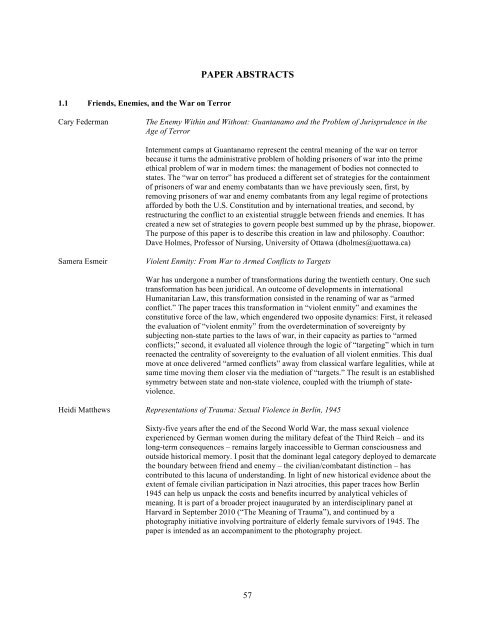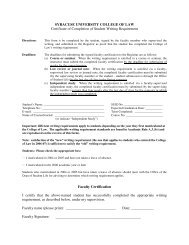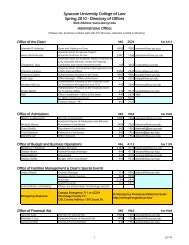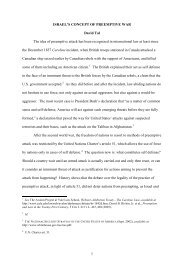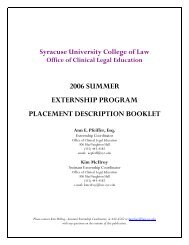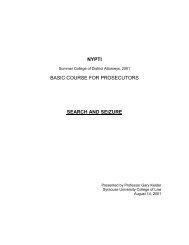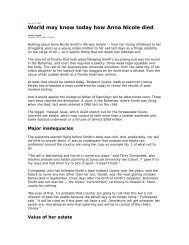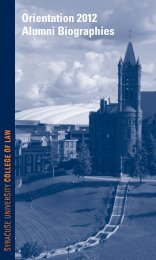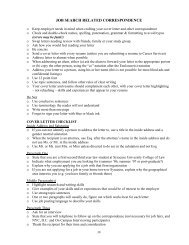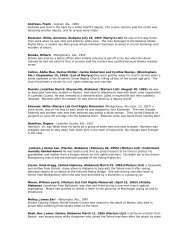2011 Conference Program (PDF) - Syracuse University College of Law
2011 Conference Program (PDF) - Syracuse University College of Law
2011 Conference Program (PDF) - Syracuse University College of Law
You also want an ePaper? Increase the reach of your titles
YUMPU automatically turns print PDFs into web optimized ePapers that Google loves.
PAPER ABSTRACTS<br />
1.1 Friends, Enemies, and the War on Terror<br />
Cary Federman<br />
The Enemy Within and Without: Guantanamo and the Problem <strong>of</strong> Jurisprudence in the<br />
Age <strong>of</strong> Terror<br />
Internment camps at Guantanamo represent the central meaning <strong>of</strong> the war on terror<br />
because it turns the administrative problem <strong>of</strong> holding prisoners <strong>of</strong> war into the prime<br />
ethical problem <strong>of</strong> war in modern times: the management <strong>of</strong> bodies not connected to<br />
states. The “war on terror” has produced a different set <strong>of</strong> strategies for the containment<br />
<strong>of</strong> prisoners <strong>of</strong> war and enemy combatants than we have previously seen, first, by<br />
removing prisoners <strong>of</strong> war and enemy combatants from any legal regime <strong>of</strong> protections<br />
afforded by both the U.S. Constitution and by international treaties, and second, by<br />
restructuring the conflict to an existential struggle between friends and enemies. It has<br />
created a new set <strong>of</strong> strategies to govern people best summed up by the phrase, biopower.<br />
The purpose <strong>of</strong> this paper is to describe this creation in law and philosophy. Coauthor:<br />
Dave Holmes, Pr<strong>of</strong>essor <strong>of</strong> Nursing, <strong>University</strong> <strong>of</strong> Ottawa (dholmes@uottawa.ca)<br />
Samera Esmeir<br />
Violent Enmity: From War to Armed Conflicts to Targets<br />
War has undergone a number <strong>of</strong> transformations during the twentieth century. One such<br />
transformation has been juridical. An outcome <strong>of</strong> developments in international<br />
Humanitarian <strong>Law</strong>, this transformation consisted in the renaming <strong>of</strong> war as “armed<br />
conflict.” The paper traces this transformation in “violent enmity” and examines the<br />
constitutive force <strong>of</strong> the law, which engendered two opposite dynamics: First, it released<br />
the evaluation <strong>of</strong> “violent enmity” from the overdetermination <strong>of</strong> sovereignty by<br />
subjecting non-state parties to the laws <strong>of</strong> war, in their capacity as parties to “armed<br />
conflicts;” second, it evaluated all violence through the logic <strong>of</strong> “targeting” which in turn<br />
reenacted the centrality <strong>of</strong> sovereignty to the evaluation <strong>of</strong> all violent enmities. This dual<br />
move at once delivered “armed conflicts” away from classical warfare legalities, while at<br />
same time moving them closer via the mediation <strong>of</strong> “targets.” The result is an established<br />
symmetry between state and non-state violence, coupled with the triumph <strong>of</strong> stateviolence.<br />
Heidi Matthews Representations <strong>of</strong> Trauma: Sexual Violence in Berlin, 1945<br />
Sixty-five years after the end <strong>of</strong> the Second World War, the mass sexual violence<br />
experienced by German women during the military defeat <strong>of</strong> the Third Reich – and its<br />
long-term consequences – remains largely inaccessible to German consciousness and<br />
outside historical memory. I posit that the dominant legal category deployed to demarcate<br />
the boundary between friend and enemy – the civilian/combatant distinction – has<br />
contributed to this lacuna <strong>of</strong> understanding. In light <strong>of</strong> new historical evidence about the<br />
extent <strong>of</strong> female civilian participation in Nazi atrocities, this paper traces how Berlin<br />
1945 can help us unpack the costs and benefits incurred by analytical vehicles <strong>of</strong><br />
meaning. It is part <strong>of</strong> a broader project inaugurated by an interdisciplinary panel at<br />
Harvard in September 2010 (“The Meaning <strong>of</strong> Trauma”), and continued by a<br />
photography initiative involving portraiture <strong>of</strong> elderly female survivors <strong>of</strong> 1945. The<br />
paper is intended as an accompaniment to the photography project.<br />
!<br />
57


